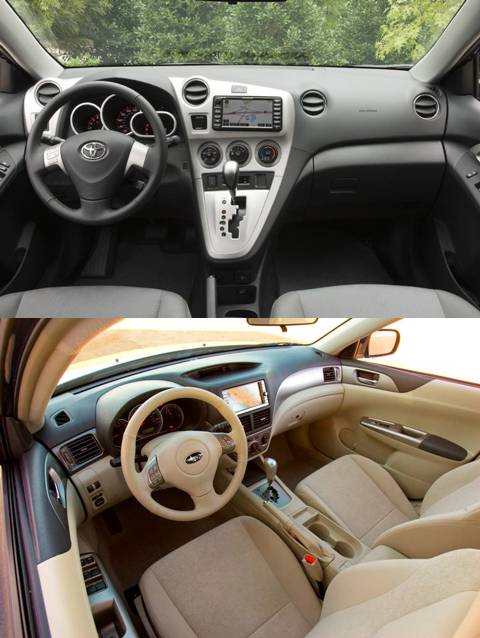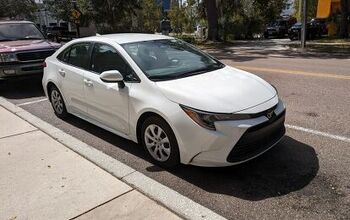2009 Toyota Matrix S AWD Vs. 2008 Subaru Impreza 2.5i 5-Door
At some point in our recent automotive history, all wheel-drive (AWD) replaced front wheel-drive as the paranoid consumer's drivetrain of choice. The safety advantages of high quality snow tires (as needed) and a low center of gravity (in all cases) got lost in translation. Ready to capitalize on the AWD's popularity: the economy-oriented Toyota Matrix and the Subaru Impreza. Both diminutive scramblers aren't nearly as cheap or efficient as their front-wheel-drive cousins, and they won't off-road, tow a boat or carry seven passengers. Still, both cars offer a [potential] extra safety margin and [potentially] better handling. So if you had to choose one…
The Impreza and the Matrix were both recently restyled. The new Matrix looks like it's been hanging in Beverly Hills. And yet, even after a nip, tuck, stretch and smooth, the Matrix' bloated-Yaris profile remains. Though the car's tighter greenhouse and diving roof line improve on the prior model's anodyne anonymity, form comes at the expense of function (more on that later).
The Impreza hatch's-sorry, "5-Door's" restyle offers a sleek, ovoid look that's both familiar and jarring. Subaru achieved this paradox by littering a restrained, attractive shape with unnecessary, eye-melting flourishes (e.g. icicle taillights, and faux-Chrysler pilot wings on the grille). Select the "sports grille" option and plain black mesh replaces your slice of plastic corporate flair, transforming the Impreza's styling. If only Subaru offered a "tasteful tail light" option…
The Matrix' one-box (one-trapezoid?) design creates a minivan-in-a-trash-compacter interior vibe (so to speak). The steep windshield and short hood enable acceptable forward vision. But the Toyota's sharply-falling roof and gun-slit windows are insupportable, they put the words "oh shit!" into "blind spot." The Matrix boasts slightly more cargo capacity than the Impreza, but the Yaris provides more hip room.
The Impreza's rearward vision is also curtailed by its sloping roofline, but at least you can check your blind spots without a periscope. Although the Subie is slightly smaller than the Matrix by most metrics– including the vital rear leg room calculation– its airy greenhouse is far more inviting than the Toyota's four-wheeled bunker.
Let's face it: adult-sized adults won't want to spend an inordinate amount of time in either back seat.
The Matrix's clean, unpretentious interior styling emphasizes function. A pervasive sense of cheapness and fragility prevents its cabin from achieving rugged or utilitarian props. The Toyota's black cockpit is brightened only by acres of the hard, shiny silver plastic that ToMoCo owners have come to know and abhor. By the same token, while the Matrix' large climate control knobs are paragons of simplicity, they're imprecise and poorly secured to the minivan-style console.
The beige-and-black Subaru four-door's interior plastics seem like close relatives of the trailer trash found in the Toyota's cockpit. Other materials are of a noticeably higher quality. And while the two-dimensional Toyota cockpit embraces appliance-dom, the Subaru wraps its occupants in a low-rent take on the BMW driver-oriented interior. If you like the Impreza's sheetmetal, the interior styling won't jar. If not, you'll find it boring, garish or (once again) both.
The AWD Matrix comes in one drivetrain flavor: a 2.4-liter inline four-cylinder engine with a four-speed automatic transmission. Pop it in "D," arrange a sour expression on your face, mash the gas and the 158hp mill will hustle the portly (3360 lbs) Matrix about with joyless adequacy. The quadra-geared slushbox helps keep fun at bay, but doesn't display the manic thrash that Berkowitz experienced with Toyota's five-speed unit (available on non-AWD Matrices).
The drivetrain's misère de vivre is a blessing in disguise; you weren't going to have fun driving the Matrix anyway. Unmanned aerial drones offer more steering feedback than the Toyota's over-boosted helm. The Matrix' pillow-soft suspension upholds this commitment to sensory deprivation. Body roll and understeer quickly define the limits of cornering ability (or lack thereof). That the AWD Matrix gets standard double wishbone rear suspension is more indicative of Toyota's product-packaging strategy than any corner-carving aptitude.
The Impreza has let itself go lately. It's packed on nearly 250 pounds compared to its autocross-dominating 2.5 RS nineties forbears. However, compared to the overfed, over-medicated Matrix, the AWD Subaru is a well-trained athlete. The trademark 2.5-liter boxer four marries 170hp with handfuls of usable torque, requiring only minimal use of the agricultural five-speed stick. Though crunchy and imprecise, the manual makes far better use of the Subie's burble 'n snarl than the lugging, laggy autobox. Both transmissions have their flaws, but it's nice to have a choice (Toyota).
No question: the Impreza's mainstream makeover has dumbed-down the car's handling. With added weight and softer springs, the Scooby tends to lean and hunt for its line, when it should be darting and planting. The payoff: serenity at speed. What the Impreza surrenders in autocrossmanship it makes up for on long trips to the cabin or trailhead.
This is not to say the Impreza is corner-aversive. The Impreza's steering is far more engaging than the Matrix'; the Subaru's helm delivers solid heft and remains in constant communication with the chassis. When the going gets curvy, the Impreza's full-time all wheel-drive routes more power to the rear wheels, allowing the Impreza to power through corners in an entirely pleasant point-and-shoot style.
In stark contrast, the Toyota system displays no hint of AWD hoonery. It only sends power to the Matrix' rear wheels when the front tires start to slip. Unless you regularly drive on dirt or gravel, you might never notice the Toyota AWD engage. Clearly, it's not an integral feature.
In sum, the AWD Matrix is the weakest offering in the Corolla/Matrix range. Nearly all the other cars are cheaper, lighter and more efficient than the AWD variant-and the Impreza. At $21,060 for a base AWD Matrix, it's well inside just-say-no territory. Especially with the $18,640 Impreza nipping at its heels.
With neither the Matrix nor the Impreza claiming a decisive EPA ratings victory (at 20/26 and 20/27 respectively), the Impreza's price point is the game-winner here. And if driving pleasure is even remotely important, the Matrix fails miserably, while the Impreza scores impressively.
Subaru's decision to take the Impreza mainstream didn't win praise from the brand faithful. But it widened the mini-wagon's distance from its competition. The only thing standing in the Impreza's path to segment dominance: mileage (back to that front wheel-drive equation). And the new, all wheel-drive Suzuki SX4, which takes the cheap-and-cheerful approach once espoused by the 'Preza. Having dispatched the Matrix AWD, we'll let you know how the Subie and the Suzi measure-up.
More by Edward Niedermeyer
Latest Car Reviews
Read moreLatest Product Reviews
Read moreRecent Comments
- Jalop1991 does the odometer represent itself in an analog fashion? Will the numbers roll slowly and stop wherever, or do they just blink to the next number like any old boring modern car?
- MaintenanceCosts E34 535i may be, for my money, the most desirable BMW ever built. (It's either it or the E34 M5.) Skeptical of these mods but they might be worth undoing.
- Arthur Dailey What a load of cow patties from fat cat politicians, swilling at the trough of their rich backers. Business is all for `free markets` when it benefits them. But are very quick to hold their hands out for government tax credits, tax breaks or government contracts. And business executives are unwilling to limit their power over their workers. Business executives are trained to `divide and conquer` by pitting workers against each other for raises or promotions. As for the fat cat politicians what about legislating a living wage, so workers don't have to worry about holding down multiple jobs or begging for raises? And what about actually criminally charging those who hire people who are not legally illegible to work? Remember that it is business interests who regularly lobby for greater immigration. If you are a good and fair employer, your workers will never feel the need to speak to a union. And if you are not a good employer, then hopefully 'you get the union that you deserve'.
- 28-Cars-Later Finally, something possibly maybe worth buying.
- EBFlex The simple fact is very small and cheap ICE vehicles have a range thats longer than all EVs. That is the bar that needs met. And EVs cannot meet that.Of course range matters. But that's one element of many that make EVs completely ineffective at replacing ICE vehicles.



































Comments
Join the conversation
I purchased a 2010 Matrix XR AWD based on the following facts: - Toyota has an ubeatable durability/reliabilty record, and a stronger dealership network; - Subaru's rust easier/faster than Toyota's; - Subaru's parts generally cost more; - Subaru's are more expensive to insure (in Canada anyway); (maybe because of all the boy racer's out there driving Impreza's, lol) - Impreza seating/ ground clearance too low; - Impreza has to be one of the ugliest vehicles on the road; So, to recap, it's not so much how Totota won me over, but rather how Subaru has turned me off. I also tested the Suzuki SX4 - small trunk space & small gas tank were deal breakers for me...
I drove a Matrix whilst my other car (a BMW, of course) was in the shop... My impression of the Matrix: cheap interior and horrible gas mileage (average of 20 mpg). My Subaru, in contrast, gets 23 to 33 mpg, and the interior, while cheap, is not repulsive and toy-like and fragile-feeling, which is how the Matrix interior felt. Both accelerate okay and both cars handle acceptably... but $23,000 for a loaded Matrix?!! No way!